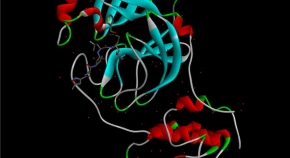Molecular docking analysis of selected phytochemicals against SARS-CoV-2 Mpro receptor
Research Articles | Published: 16 October, 2020
First Page: 766
Last Page: 781
Views: 3865
Keywords: Coronavirus, Phytochemicals, Molecular docking, Molecular dynamics
Abstract
Presently world is on a war with the novel coronavirus and with no immediate treatments available the scourge caused by the SARS-CoV-2 is increasing day by day. A lot of researches are going on for the potential drug candidate that could help the healthcare system in this fight. Plants are a natural data bank of bioactive compounds. Many phytochemicals are being studied for various ailments including cancer, bacterial and viral infections, etc. The present study aims to screen 38 bioactive compounds from 5 selected plants viz., Azadirachta indica, Curcuma longa, Zingiber officinale, Ocimum basilicum and Panax ginseng against SARS-CoV-2. Lipinski’s rule was taken as the foundation for initial screening. Shortlisted compounds were subjected to molecular docking study with Mpro receptor present in SARS-CoV-2. The study identified that gedunin, epoxyazadiradione, nimbin and ginsenosides have potential to inhibit Mpro activity and their binding energies are − 9.51 kcal/mol, − 8.47 kcal/mol, − 8.66 kcal/mol and − 9.63 kcal/mol respectively. Based on bioavailability radar studies gedunin and epoxyazadiradione are the two most potent compounds which are used for molecular dynamics simulation studies. Molecular dynamics studies showed that gedunin is more potent than epoxyazadiradione. To find the effectiveness and to propose the exact mechanism, in-vitro studies can be further performed on gedunin.

References
- Chang GG (2010) Quaternary structure of the SARS coronavirus main protease. Molecular biology of the SARS-Coronavirus. Springer, Berlin, pp 115–128
- Chang JS, Wang KC, Yeh CF, Shieh DE, Chiang LC (2013) Fresh ginger (Zingiber officinale) has anti-viral activity against human respiratory syncytial virus in human respiratory tract cell lines. J Ethnopharmacol 145:146–151
- Chen J (2020) Pathogenicity and transmissibility of 2019-nCoV-A quick overview and comparison with other emerging viruses. Microbes Infect 22:69–71
- Daina A, Michielin O, Zoete V (2017) SwissADME: a free web tool to evaluate pharmacokinetics, drug-likeness and medicinal chemistry friendliness of small molecules. Sci Rep 7:42717
- Dao TT, Nguyen PH, Won HK, Kim EH, Park J, Won BY, Oh WK (2012) Curcuminoids from Curcuma longa and their inhibitory activities on influenza A neuraminidases. Food Chem 134:21–28
- Gao L, Xu J, Chen S (2020) In silico screening of potential Chinese herbal medicine against COVID-19 by targeting SARS-CoV-2 3CLpro and angiotensin converting enzyme II using molecular docking. Chin J Integr Med 26:527–532
- Huang C, Wang Y, Li X, Ren L, Zhao J, Hu Y, Zhang L, Fan G, Xu J, Gu X, Cheng Z, Yu T, Xia J, Wei Y, Wu W, Xie X, Yin W, Li H, Liu M, Xiao Y, Gao H, Guo L, Xie J, Wang G, Jiang R, Gao Z, Jin Q, Wang J, Cao B (2020) Clinical features of patients infected with 2019 novel coronavirus in Wuhan, China. Lancet 395:497–506
- Jin Z, Du X, Xu Y, Deng Y, Liu M, Zhao Y, Zhang B, Li X, Zhang L, Peng C, Duan Y, Yu J, Wang L, Yang K, Liu F, Jiang R, Yang X, You T, Liu X, Yang X, Bai F, Liu H, Liu X, Guddat LW, Xu W, Xiao G, Qin C, Shi Z, Jiang H, Rao Z, Yang H (2020) Structure of Mpro from SARS-CoV-2 and discovery of its inhibitors. Nature 582:289–293
- Kang S, Im K, Kim G, Min H (2017) Antiviral activity of 20(R)-ginsenoside Rh2 against murine gammaherpesvirus. J Ginseng Res 41:496–502
- Kaushik S, Jangra G, Kundu V, Yadav JP, Kaushik S (2020) Anti-viral activity of Zingiber officinale (Ginger) ingredients against the Chikungunya virus. VirusDisease. https://doi.org/10.1007/s13337-020-00584-0
- Kumar VS, Navaratnam V (2013) Neem (Azadirachta indica): Prehistory to contemporary medicinal uses to humankind. Asian Pac J Trop Biomed 3:505–514
- Lipinski CA (2004) Lead- and drug-like compounds: the rule-of-five revolution. Drug Discov Today Technol 1:337–341
- Mirza MU, Froeyen M (2020) Structural elucidation of SARS-CoV-2 vital proteins: Computational methods reveal potential drug candidates against main protease, Nsp12 polymerase and Nsp13 helicase. J Pharm Anal. https://doi.org/10.1016/j.jpha.2020.04.008
- Sornpet B, Potha T, Tragoolpua Y, Pringproa K (2017) Antiviral activity of five Asian medicinal pant crude extracts against highly pathogenic H5N1 avian influenza virus. Asian Pac J Trop Med 10:871–876
- Wang D, Hu B, Hu C, Zhu F, Liu X, Zhang J, Wang B, Xiang H, Cheng Z, Xiong Y, Zhao Y, Li Y, Wang X, Peng Z (2020) Clinical characteristics of 138 hospitalized patients with 2019 novel Coronavirus-infected pneumonia in Wuhan. China JAMA 323:1061
Author Information
Department of Biotechnology, Delhi Technological University, Delhi, India